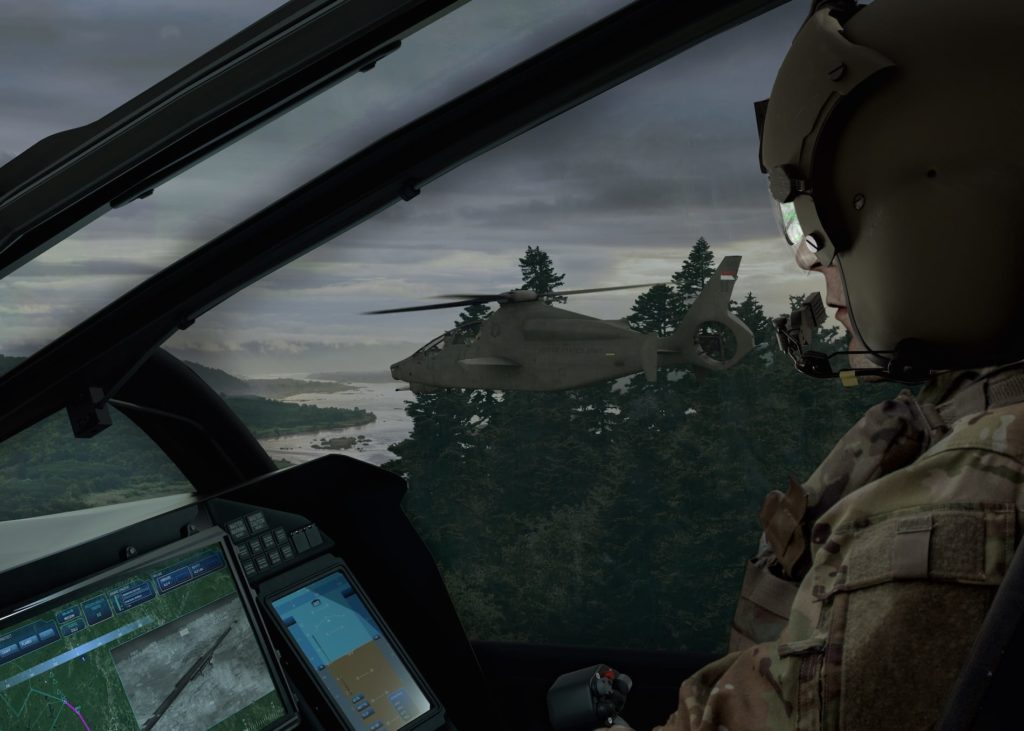Bell’s 360 Invictus futuristic attack helicopter is about 30 percent complete in Amarillo, Texas, with remaining construction on track for a first flight by the end of 2022.
Most of the interior structure and fuselage skin of the prototype aircraft are in place, according to Keith Flail, Bell’s vice president of advanced vertical lift systems.

“You see a lot of structure and skins coming together on the aircraft and we’re about to begin systemization of the aircraft,” Flail told reporters during Bell’s virtual media day on March 24. “We’re still on the path to have the aircraft complete to execute ground runs in the summer of 2022 with first flight shortly after that.”
“From nose to tail, you’d see all the structure that it takes from the front bulkhead to the cockpit area to the firewall assembly for the engine, the tail of the aircraft,” Flail added. “It really looks like the skeleton, if you will.”
The sharklike Invictus, a conventional single-rotor helicopter with a canted tail rotor and what Bell calls a “low-drag configuration,” is one of two aircraft that could become the U.S. Army’s new Future Attack Recon Aircraft (FARA). The 360 is designed to Army specifications that FARA fit into a 40-foot (12 meter) square box and should cruise at 180 knots or faster. Invictus should have a combat radius of 135 nautical miles with more than 90 minutes of time on station and achieve 4k/95F hover out of ground effect (HOGE).
Bell was selected to continue into the competitive design and risk-reduction phase of FARA in March 2020, alongside Sikorsky and its Raider X compound coaxial helicopter. A flyoff between the two prototypes is scheduled for 2023.
Fielding in the 2030s, FARA should take on the armed scout helicopter role vacated by retirement of the OH-58D Kiowa Warrior that is currently being performed by AH-64 Apache gunships teamed with RQ-7 Shadow drones.
An Army Requirements Oversight Council, which weighs and OKs future weapon system attributes, is scheduled to consider the FARA system — aircraft, weapons, avionics and mission systems — in April. That AROC should formalize some of the requirements for the aircraft that will move into engineering and manufacturing development, which will polish a chosen design for production and fielding, Flail said.
“There are actually two baselines that we are executing at the same time,” Flail said. “The baseline for the competitive prototype and at the same time, forward looking to the engineering and manufacturing development for the Increment I aircraft, which is really the full weapon system where you have the mission systems, all the weapons, everything that’s required to have the aircraft be a weapon system that can go to combat.”

Bell’s FARA pitch is designed with the Army’s pocketbook in mind. The company has rummaged through its trove of existing and developmental rotorcraft technologies to assemble a futuristic, more capable but ultimately conventional FARA offering.
“For FARA, we are focused on providing the lowest-cost, lowest-risk, most sustainable solution,” Flail said. “We have had the opportunity, given this very compressed schedule that FARA is on, to leverage a lot out of the commercial side of our business.”
Invictus borrows several technologies — the rotor system, rotor dynamics, gear boxes and flight control system — from the 525 Relentless commercial helicopter.
“Anyone familiar with rotorcraft will know that those areas are typically on your critical path, the elements that drive your schedule most significantly,” Flail said. “So that’s been a huge advantage that we’ve had in order to execute the program.”









